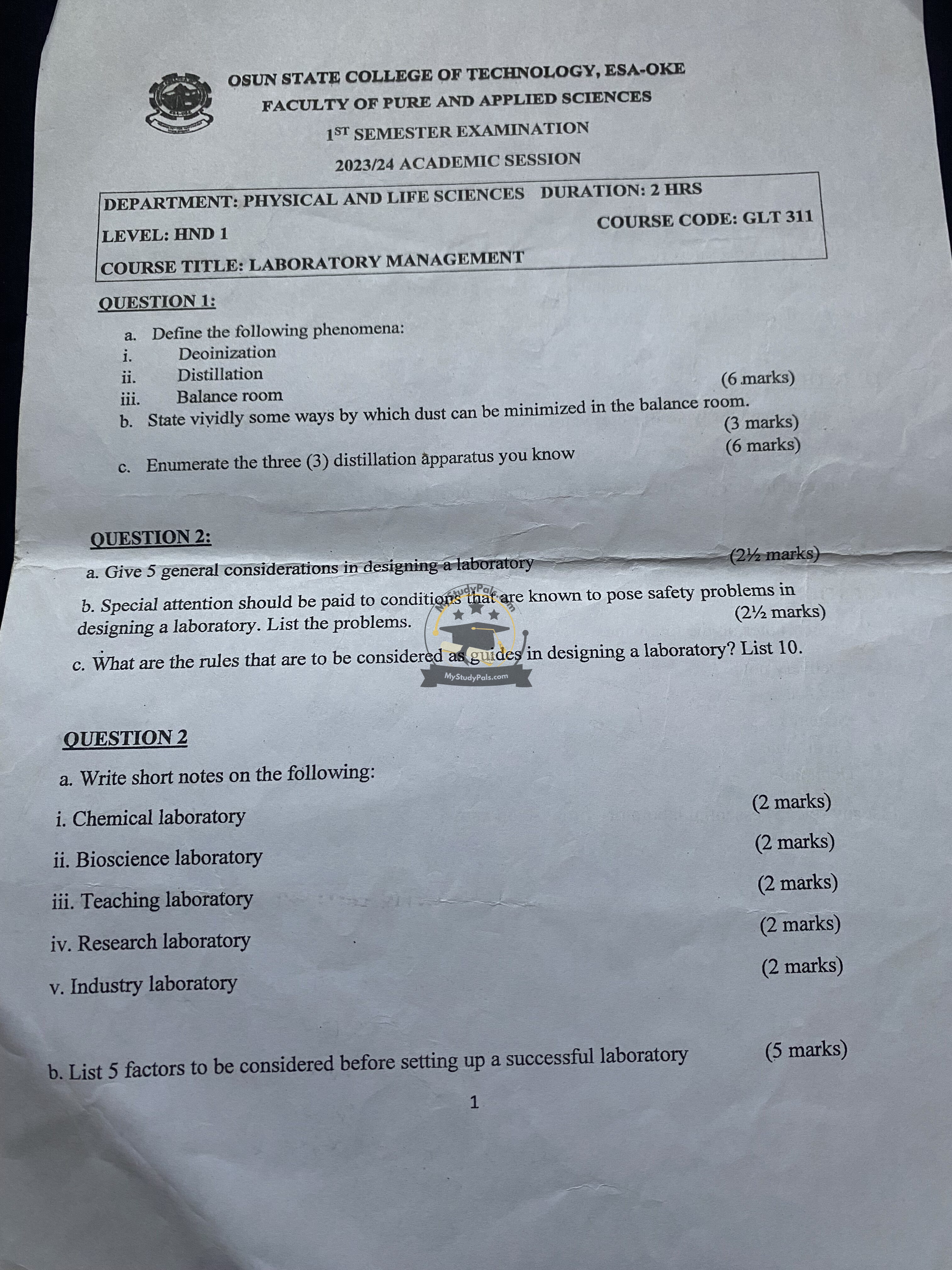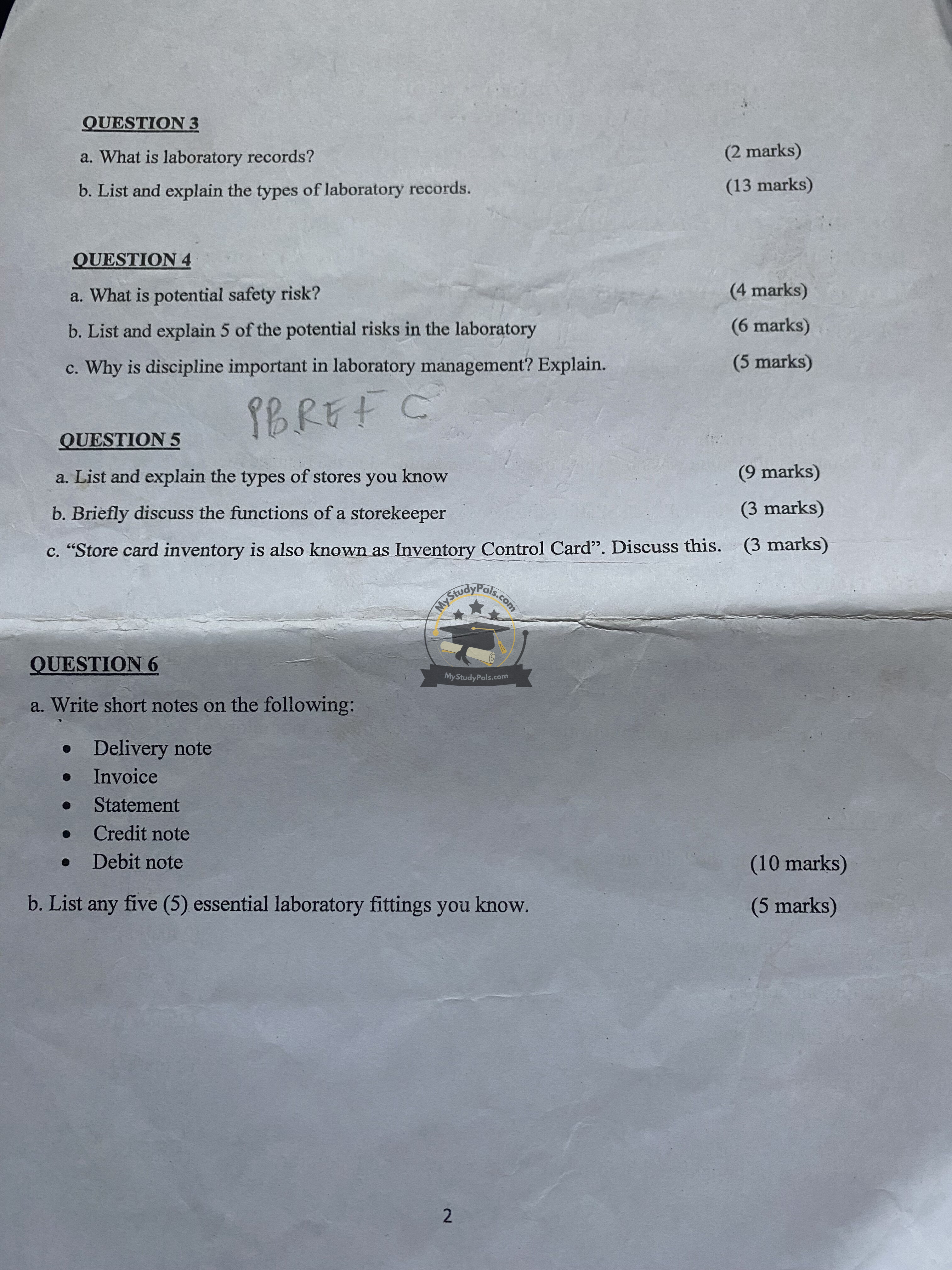ANWSER
Question 1:
a. Define the following phenomena:
i. Deionization – The process of removing ionized minerals and salts from water using ion-exchange resins, resulting in highly pure water.
ii. Distillation – A purification process that involves heating a liquid to form vapor and then condensing it back into a liquid to separate components based on boiling points.
iii. Balance Room – A controlled environment in a laboratory where precision balances are kept to ensure accurate measurements, minimizing environmental disturbances.
b. State vividly some ways by which dust can be minimized in the balance room.
- Regular cleaning and dusting
- Use of air filters or purification systems
- Keeping the room enclosed and limiting access
- Maintaining proper ventilation
- Storing chemicals properly to prevent airborne particles
c. Enumerate the three (3) distillation apparatus you know.
- Simple distillation setup
- Fractional distillation apparatus
- Vacuum distillation setup
Question 2:
a. Give five (5) general considerations in designing a laboratory.
- Adequate space and layout planning
- Proper ventilation and fume extraction
- Safety measures and emergency exits
- Availability of utilities (water, gas, electricity)
- Compliance with regulations and standards
b. Special attention should be paid to conditions that pose safety problems in designing a laboratory. List the problems.
- Fire hazards from flammable substances
- Chemical spills and contamination risks
- Poor ventilation leading to toxic fumes accumulation
- Inadequate emergency exits and equipment
- Electrical hazards from faulty wiring
c. What are the rules that are to be considered as guides in designing a laboratory? List 10.
- Proper lighting and ventilation
- Clearly marked emergency exits
- Use of fire-resistant materials
- Adequate storage for chemicals and equipment
- Installation of fume hoods and extraction fans
- Separation of hazardous and non-hazardous areas
- Proper waste disposal systems
- Ergonomic workstation designs
- Accessibility for disabled persons
- Compliance with safety standards and protocols
Question 3:
a. What is laboratory records?
Laboratory records refer to the systematic documentation of experiments, tests, procedures, and inventory in a lab setting to ensure accuracy, traceability, and compliance with regulations.
b. List and explain the types of laboratory records.
- Experimental records – Notes on methods, observations, and results of experiments.
- Inventory records – Documentation of lab equipment and chemical stock.
- Safety records – Reports on accidents, safety drills, and risk assessments.
- Maintenance records – Logs of equipment servicing and calibration.
- Personnel records – Details of staff training, qualifications, and attendance.
- Quality control records – Documentation of tests to ensure consistency and accuracy.
- Waste disposal records – Records of hazardous waste management.
- Purchase and supply records – Documentation of ordered and received lab materials.
Question 4:
a. What is potential safety risk?
A potential safety risk is any condition, substance, or practice in a laboratory that could lead to accidents, injuries, or hazardous exposure if not properly managed.
b. List and explain 5 of the potential risks in the laboratory.
- Chemical spills – Can cause burns, contamination, or toxic fumes.
- Fire hazards – From flammable substances or faulty electrical connections.
- Glass breakage – Risk of injury from shattered lab glassware.
- Biological hazards – Exposure to harmful microorganisms.
- Radiation hazards – Risks from handling radioactive materials.
c. Why is discipline important in laboratory management? Explain.
Discipline ensures adherence to safety protocols, accuracy in experimental procedures, proper maintenance of records, and overall efficiency in laboratory operations. It minimizes risks and enhances productivity.
Question 5:
a. List and explain the types of stores you know.
- General stores – Stores that keep common laboratory supplies.
- Chemical stores – Storage specifically for chemicals with controlled conditions.
- Equipment stores – Holds laboratory instruments and tools.
- Cold storage – Used for perishable lab materials, such as biological samples.
- Radioactive stores – Secure areas for storing radioactive substances.
b. Briefly discuss the functions of a storekeeper.
- Managing inventory and keeping accurate records
- Ensuring proper storage of materials
- Issuing supplies to lab personnel
- Monitoring stock levels and reordering supplies
- Ensuring compliance with safety regulations
c. “Store card inventory is also known as Inventory Control Card.” Discuss this.
A store card inventory, or inventory control card, is a record-keeping tool used to track the movement of stock within a store. It provides details on item quantities, purchases, usage, and remaining balance, helping in efficient inventory management.
Question 6:
a. Write short notes on the following:
- Delivery note – A document sent with goods confirming their delivery.
- Invoice – A bill listing goods supplied and their costs.
- Statement – A summary of transactions between two parties over a period.
- Credit note – A document issued to correct overcharges or return of goods.
- Debit note – A document notifying a buyer of additional charges.
b. List any five (5) essential laboratory fittings you know.
- Fume hood
- Emergency shower and eyewash station
- Laboratory bench with sinks
- Fire extinguisher
- Chemical storage cabinet



